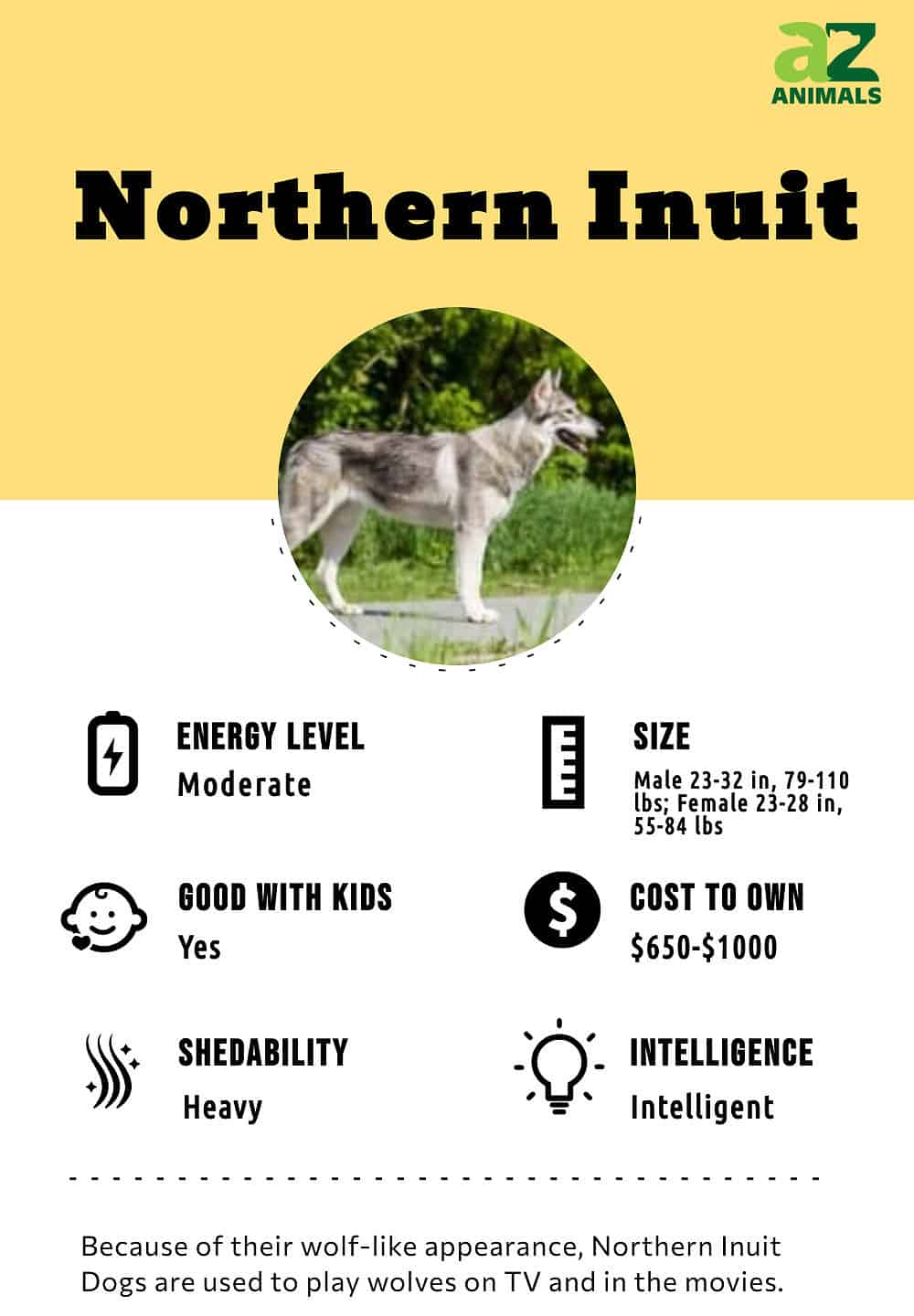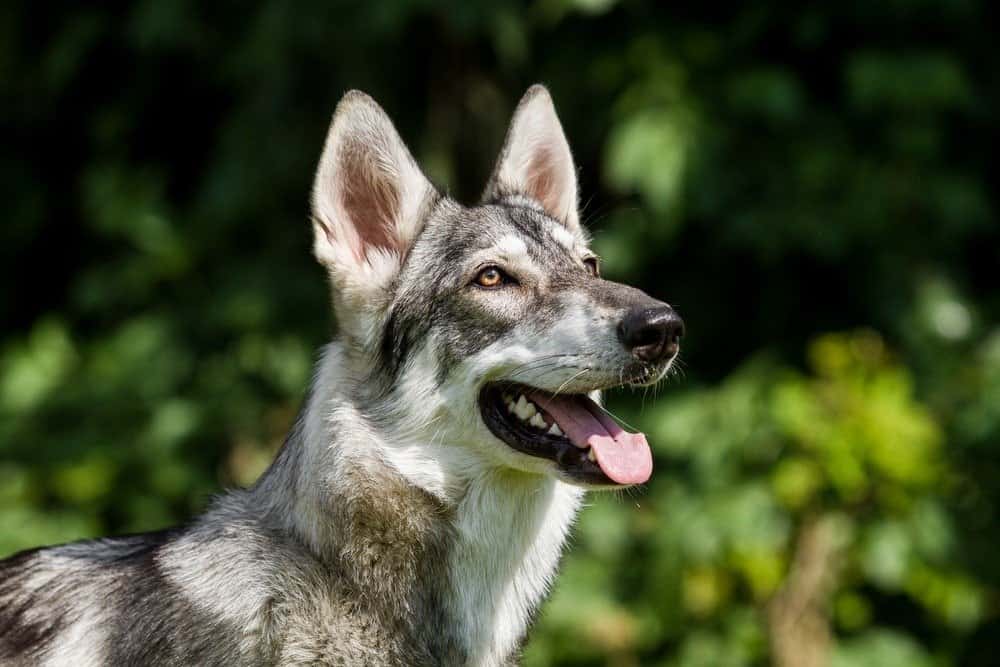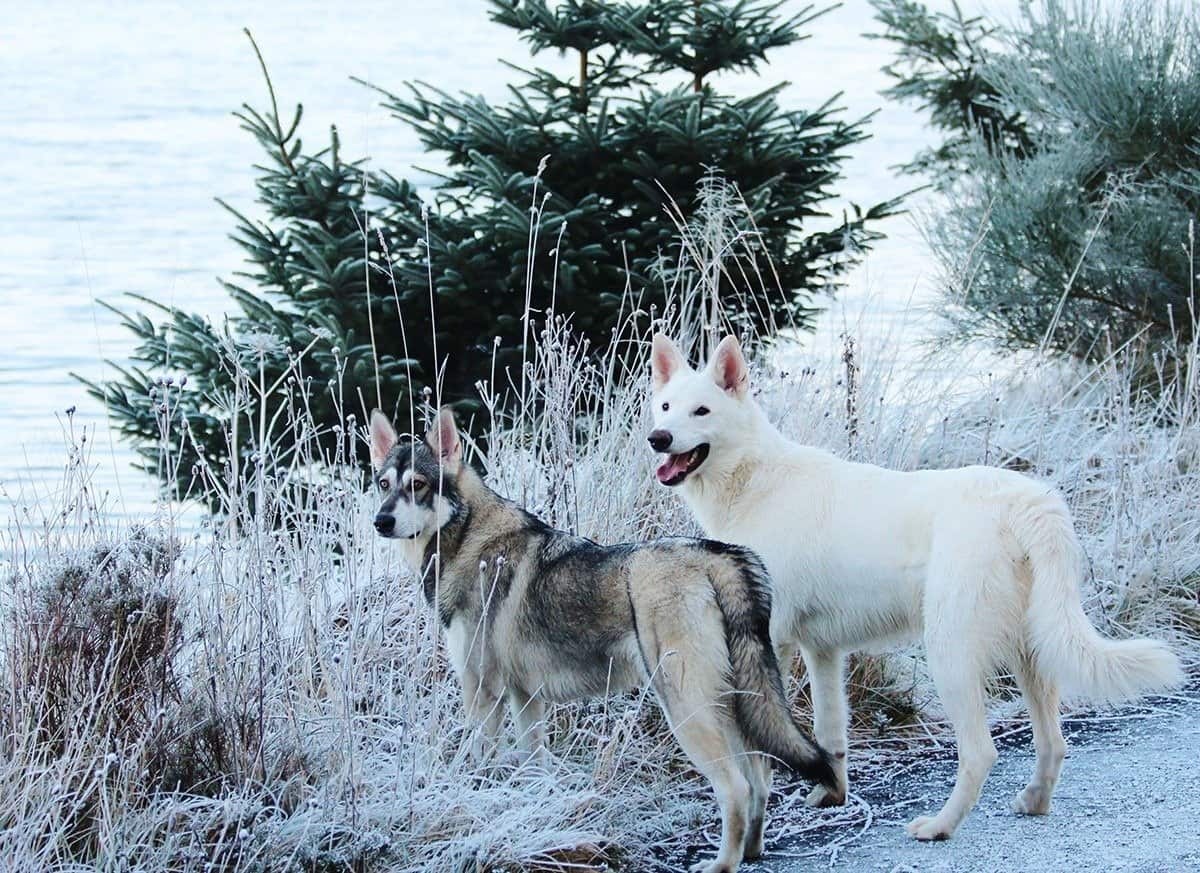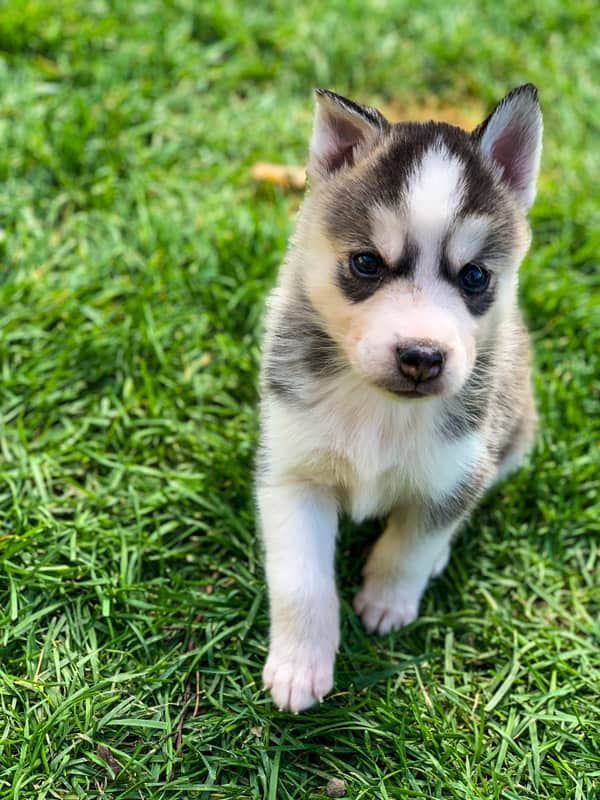Northern Inuit Dog
Canis lupus
Advertisement
Northern Inuit Dog Scientific Classification
- Kingdom
- Animalia
- Phylum
- Chordata
- Class
- Mammalia
- Order
- Carnivora
- Family
- Canidae
- Genus
- Canis
- Scientific Name
- Canis lupus
Read our Complete Guide to Classification of Animals.
Northern Inuit Dog Conservation Status
Northern Inuit Dog Facts
- Common Name
- Northern Inuit Dog
Northern Inuit Dog as a Pet:
- General Health
- Energy Level
- Shedability
- Trainability
- Intelligence
- Tendency to Chew
- Size
- Family and kid friendliness
- Yappiness / Barking
- High
- Separation Anxiety
- Moderate
- Preferred Temperature
- Average climate
- Exercise Needs
- High
- Friendly With Other Dogs
- Moderate
- Pure bred cost to own
- $800 to $1,000
- Dog group
- Working
- Male weight
- 79-110 lbs
- Female weight
- 55-84 lbs
This post may contain affiliate links to our partners like Chewy, Amazon, and others. Purchasing through these helps us further the A-Z Animals mission to educate about the world's species.
View all of the Northern Inuit Dog images!
Northern Inuit Dogs may look very similar to wolves, but they actually do not have any wolf DNA.

Northern Inuit dogs were bred from dogs such as Siberian Huskies, German Shepherds, and Alaskan Malamutes to look like a wolf while still retaining positive traits that are associated with domesticated dogs. Inuit Dogs can make a great family pet. They are very loyal and friendly. However, they can be a challenge to train for first time owners, so this breed will do best with an experienced owner.
See all of our expert product reviews.
Ownership: 3 Pros and Cons
| Pros | Cons |
|---|---|
| Friendly: Northern Inuit Dogs are very friendly. They interact well with both strangers and members of the family. | Challenging for first time owners: Northern Inuit dogs are best suited for experienced owners. They can be challenging to train if you have not worked with this breed before. |
| Healthy: This breed is relatively healthy. They don’t have as many medical conditions as some other breeds. | Not a good guard dog: Northern Inuit Dogs are too friendly to make a good guard dog. |
| Good with other dogs: This breed typically gets along well with other dogs. This means they would be a good choice for homes with other dogs or planning to adopt multiple dogs. | May develop separation anxiety: Northern Inuit Dogs don’t like being left alone for long periods of time. They are more likely than some other dog breeds to suffer from separation anxiety. |
Size and Weight

Northern Inuit males are typically larger than the females, weighing over 20 pounds more as adults.
©Aneta Jungerova/Shutterstock.com
These Dogs are a medium- to large-size dog breed. Males are typically significantly larger than females. They can weigh between 79 and 110 pounds and are between 23 and 32 inches tall. Females, on the other hand, generally weight between 55 and 84 pounds and are between 23 and 28 inches tall.
| Size | Male | Female |
|---|---|---|
| Height | 23 inches to 32 inches | 23 inches to 28 inches |
| Weight | 79 pounds to 110 pounds | 55 pounds to 84 pounds |
Common Health Issues
Before you bring home a Northern Inuit dog, there are a few common health concerns this breed faces that you should know about. Reading about these health concerns can help ensure that you are ready to provide the highest levels of care possible for your dog.
Hip dysplasia is one health concern you should be aware of. Hip dysplasia is an inherited condition where a dog’s hip bone and thighbone don’t connect together properly. This causes the bones to rub together, which gets painful over time. Dogs with hip dysplasia may develop a limp.
Health and Entertainment for your Northern Inuit Dog
See all of our expert product reviews.
These dogs may also suffer from cryptorchidism. This is a condition in which both or one of the dog’s testes do not drop. Dogs with this problem will need to be castrated, but they can then go on to live a normal life. This breed’s lifespan is between 12 and 15 years.
Another potential health concern for this breed is degenerative myelopathy. This progressive disease affects a dog’s spinal cord beginning around the time it is 8 to 14 years old. At first, dogs will seem to be uncoordinated and may appear to drag their feet. Eventually, degenerative myelopathy will progress to the point that a dog is unable to walk at all.
To review, a few potential health concerns for these dogs include:
- Hip dysplasia
- Cryptorchidism
- Degenerative myelopathy
Temperament and Behavior

Northern Inuit Dogs are intelligent, loyal, and friendly, but also strong-willed.
©Aneta Jungerova/Shutterstock.com
These intelligent Northern Inuit Dogs have a very loyal and friendly personality. These traits make this breed a great option for a family, but they will form a strong bond with their main human.
However, owners will need to make sure that their higher activity level needs are met, or they could engage in destructive behaviors. This breed can be a bit strong-willed, so they will do best with an experienced owner who knows how to properly train them.
Care
Before planning how you’ll care for your Northern Inuit Dog, you should think about the nutritional needs, common health problems, temperament, and other unique characteristics of this breed.
Best Dog Food
Many of these dogs have a sensitive stomach, so choosing a high-quality dog food is essential. Many dogs do well with kibble from a reputable manufacturer that contains a good amount of proteins and fats. You may also choose to feed them a raw diet. Whichever option you select, be sure to stay away from foods that are too sugary as these could be bad for their health.
Very young dogs (under the age of six months) have smaller stomachs and will need to eat between three and four times every day. After a puppy is six months old, it should be fine transitioning to eating about twice a day.
Our pick at A-Z Animals of the best dog food for Northern Inuits is Victor Purpose – Performance, Dry Dog Food.
With probiotics, this beef and chicken food promotes ideal digestion for this breed that can struggle with a sensitive stomach. As a result, your Northern Inuit’s immune system will be more robust. Additionally, the amino acids and antioxidants help trigger cell regeneration and a functioning nervous system.
Victor Purpose Performance Dog Food is available on Chewy or Amazon.
- 26% multi-protein, gluten free dry dog food
- Aids in dog's digestion, immune system function and healthy skin and coat
- Contains selenium yeast, prebiotics and probiotics, and mineral complexes for optimum health
Maintenance and Grooming

Northern Inuit dogs have a double coat and, therefore, are heavy shedders.
©the Northern Inuit Society / CC BY-SA 4.0 – Original / License
Northern Inuit dogs have a double coat and are very heavy shedders, particularly during their shedding seasons in the fall and spring. During these shedding seasons, you will need to brush your dog every day to reduce the amount of hair that is left around your home. During other times in the year, brushing your dog a few times a week should be sufficient.
They should not be bathed too frequently. Their coats are designed to repel dirt, and bathing them too often could cause it to lose these properties.
In addition to brushing your dog, be sure to brush its teeth, clean its ears, and trim its nails on a regular basis.
Training
These dogs can be a challenge to train. They do best with an experienced trainer who has worked with the breed before. Whether training your dog yourself or looking for obedience training classes near you, look for options that use positive reinforcement. This breed will not respond well to training methods that use negative reinforcement.
Socialization from an early age is also very important with this breed. This will help your dog learn how to interact with people and other pets. It will also help it learn how to act in different situations.
Exercise
These Northern Inuit Dogs are an active breed, but don’t need as much exercise as some other breeds. You should strive to give your dog between an hour and an hour and a half of exercise each day. Taking your pup for two walks a day and playing with it inside or in the backyard can help fulfill its need for exercise.
Puppies
There are not many breeders in North America that offer Northern Inuit puppies. For this reason, you may find long waiting lists to bring home a puppy. Also, unless a breeder lives near you, be prepared to arrange to transport a new puppy to your home.

Be sure to purchase your Northern Inuit puppy from a reputable breeder and stock up on dog supplies.
©iStock.com/Lora Letasky
Always choose a reputable breeder and avoid adopting a puppy from a puppy mill. Puppy mills do not provide the same level of care to the dogs and don’t take health concerns or temperament into account when breeding dogs.
Before you bring a dog home, make sure your home is ready. Remove anything that could be potentially dangerous to a puppy from your space. Purchase food and all the other necessary supplies that your dog will need so you have everything ready when you bring home your new dog.
Children
When trained and socialized from an early age, these dogs can make excellent pets for a family with children. They are very friendly and loving dogs who do well with children. Even though they are tolerant of children, you should always closely supervise your children when they are around this breed or any other dog breeds. This will reduce the chances of an accidental injury to either the dog or the child.
Similar Dogs
Tamaskans, Siberian Huskies, and Alaskan Malamutes are three dog breeds that have some things in common with Northern Inuit Dogs.
- Tamaskan: While Northern Inuit Dogs are a crossbreed, Tamaskans are purebred dogs. Both breeds are affectionate, sensitive, and make good pets for families with children.
- Siberian Husky: Siberian Huskies and Northern Inuit Dogs both have a strong impulse to roam. They are also both a family-friendly breed. However, a Northern Inuit Dog is larger in size than a Siberian Husky. Male Northern Inuit Dogs have an average weight of 94.5 pounds, while male Siberian Huskies only weigh between 45 and 60 pounds.
- Alaskan Malamute: Both breeds are also pretty heavy shedders. Alaskan Malamutes are usually a bit more playful and social than Northern Inuit Dogs.
Famous
Because of their wolf-like appearance, these dogs have been used to play wolves in different TV shows and movies. Most famously, this breed was used to play young Direwolves in Season 1 of HBO’s Game of Thrones series. These Northern Inuit Dogs were also used to play Rollo in the Outlander series from Starz.
Popular Names
The list below is designed to provide you with some inspiration if you are looking for the perfect name for your Inuit dog.
- Alpine
- Bear
- Dakota
- Storm
- Timber
- Miska
- Shila
- Nini
- Suka
- Tanana
Northern Inuit Dog FAQs (Frequently Asked Questions)
How much does Northern Inuit Dog cost to own?
The cost to purchase a Northern Inuit Dog from a breeder is typically between $800 and $1,000. If you can find a Northern Inuit Dog from a rescue organization or a shelter, you should expect to pay around $300 to cover adoption fees.
Other expenses you should consider before adopting a dog include veterinary bills, training classes, food, toys, and supplies. Expect the cost for these to be highest your first year. You could spend $1,000 or more your first year with your new dog to purchase everything you’ll need. Each of the following years, you should still expect to spend $500 to $1,000 to care for your dog.
Is Northern Inuit Dog good with kids?
Yes, Northern Inuit Dogs are good with kids. They are very loving and friendly. It will be important to begin training and socializing your dog from a very early age to make sure they know how to interact with children.
How long does Northern Inuit Dog live?
The lifespan of a Northern Inuit Dog is between 12 and 15 years.
Do Northern Inuit Dogs make good pets?
A Northern Inuit Dog can make an excellent pet. This breed is extremely friendly and enjoys spending time with his family. It will be important to make sure your dog gets plenty of exercise; this is not a good breed for individuals who are not very active. They can also develop separation anxiety, so you also shouldn’t choose this breed if no one is home for most of the day.
Is a Northern Inuit a wolf dog?
While Northern Inuit Dogs look very much like a wolf, they are not actually wolf dogs. They were crossbred from dogs such as Alaskan Malamutes, Siberian Huskies, and German Shepherds so that they would resemble a wolf while maintaining the even temperament of a domestic dog.
How big are Northern Inuit Dogs?
Northern Inuit dogs are a medium- to large-sized breed. Males generally weigh between 79 and 110 pounds and are between 23 and 32 inches tall. Females are smaller and weigh between 55 and 84 pounds. Females are between 23 and 28 inches tall.
Do Northern Inuit Dogs shed?
Yes, Northern Inuit Dogs shed. At some points in the year, it will be a more manageable amount, but during their shedding seasons in the fall and spring, they will shed a lot of hair. You will need to brush them every day to prevent their hair from being left all over the house.
Are Northern Inuit Dogs herbivores, carnivores, or omnivores?
Northern Inuit Dogs are Carnivores, meaning they eat other animals.
What Kingdom do Northern Inuit Dogs belong to?
Northern Inuit Dogs belong to the Kingdom Animalia.
What is the scientific name for the Northern Inuit Dog?
The scientific name for the Northern Inuit Dog is Canis lupus.
Thank you for reading! Have some feedback for us? Contact the AZ Animals editorial team.
Sources
- Northern Inuit Society / Accessed December 2, 2020
- Wikipedia / Accessed December 2, 2020



















